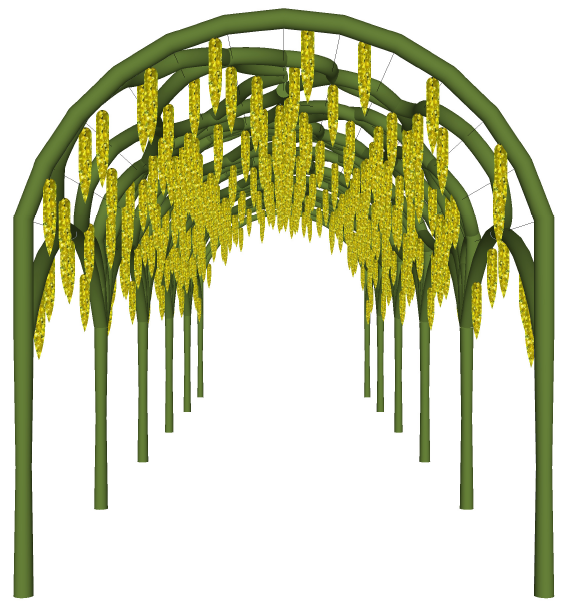
The Garden
St. Mary’s Pleasance is a private garden maintained for the public by Haddington Garden Trust SCIO, a charity that relies on grants, donations and gifts to maintain and develop the garden.
The garden occupies 1.6 acres between St. Mary's Churchyard, Lady Kitty's Garden and Haddington House, which dates from 1648 and is the oldest dwelling in Haddington.
A Walk Round the Garden: Insights into the Landscaping Features and Plants Used
THE SUNKEN GARDEN
Excavated in 1975. The formal parterre design based on the Queen’s Garden at Kew, consists of a circular central bed and four corner beds each with Box (Buxus sempervirens) borders, enclosing shrubs of Lavender Cotton(Santolina neopolitana) , Sea Wormwood (Santolina chamaecyparissus) and Sage (Salvia officinalis and purpurea). Other plants in the sunken garden are Lavender (Lavandula spica), Lambs Tongue (Sachys lanata), Greater Periwinkle (Vinca major) and Germander (Teucrium chamaedrys).
THE CENTRAL GRASSED AREA
This still has the form of the original orchard for Haddington House. Special trees to look out for are an apple tree planted by HM Queen Elizabeth in 1973, a mulberry (Morus Nigra) planted by HM Queen Elizabeth, the Queen Mother in 1976
and a Wild Service Tree (Torminalis Sorbus) planted to commemorate the death of Prince Philip, Duke of Edinburgh in 2022. Other notable trees are an Indian Bean tree (Catalpa bignonioides) and a Medlar (Mespilusgermanica). The grassed area is completed on the east side by a Haha.
THE LOTHIAN PLAYERS GARDEN
The Lothian Players Garden was endowed in 1998 by Friends of the Lothian Players, an amateur theatrical group active in the 1970’s and 80’s. The garden was replanted in 2013 with a mixture of heritage perennial shrubs and bordered by the Hornbeam allée.
HORNBEAM AND LABURNUM
The alle of 31 Hornbeam (Carpinus betulus) was planted in 1979and pruned annually. The pleached allée of 34 Scotch Laburnum (Laburnum alpinum) was planned in 1974 but not planted until 1976, with just three replacement trees since then. The Laburnum allée is arguably the best in Scotland, the racemes most prominent in late May early June. The Hamilton Border provides a backdrop to enhance the fine march wall with St Mary’s Church
SAINT MARY’S GATE
Leading to St Mary’s Parish Church was opened in 1974. The handsome gate and stone pillars were gifted. The Plaque on the left of the gate commemorates the restoration of the garden linked to the rekindling of The Lamp of the Lothians. The Plaques to the right of the gateway commemorate the 14th Duke of Hamilton, his wife and the other founder members of the Lamp of Lothian Trust.
THE MOUNT
The Mount was constructed in 1975 as part of the garden’s redesign with material taken from the Sunken Garden. The circular seat is a millstone moved from the Poldrate Granary. The Mount copies a similar feature at The Royal Botanic Gardens Kew and affords great views of St Mary’s Church, Lady Kitty’s Doo’cot, The Nungate Bridge and the River Tyne. The sides of the Mount are covered in Box (Buxus sempervirens).
THE COMMUNITY ORCHARD
The Community Orchard occupies the east end of the garden, was created from scratch in 2009 following a grant from the Big Lottery Fund. Starting with the removal of old trees and undergrowth, the ground was prepared and planted with historic species of fruit trees (apples, plums, cherries, quince and nuts). Thousands of spring bulbs were planted by school children and the whole area planted with wildflower meadow seed. Footpaths have been mown through the orchard and experiments continue to enhance the variety of wildflowers and the biodiversity of the site.
THE HERB GARDEN
Four raised herb beds with different applications.
THE COTTAGE GARDEN
This is regularly updated with a mix of period plants and vegetables to represent an old fashioned Scottish Garden. Surrounded by a mixed species hedge and adjoining the Apple house it is a wonderful, sheltered spot to sit and ponder.
THE ROSE BORDER
Planted with period species shrub and climbing roses (all named) and adjoining Haddington House. Backed up by a large fig tree and a large specimen of Irish Yew (Taxus baccata ‘Fastigiata Aurea’).









